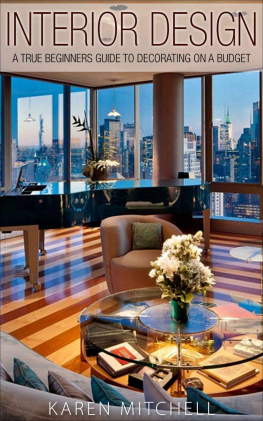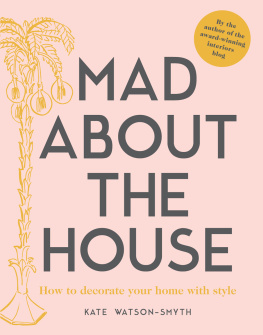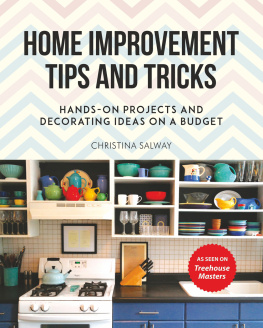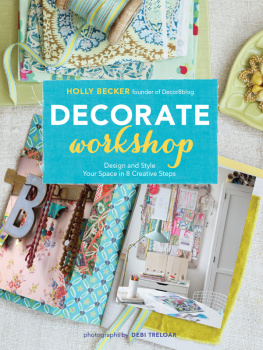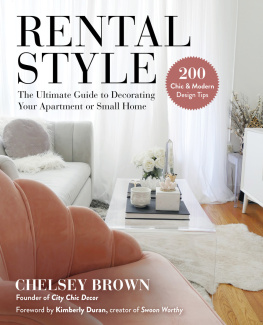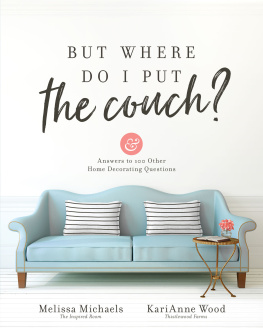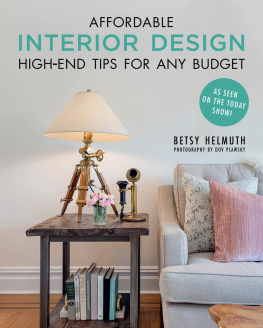A True Beginners Guide to Decorating on a Budget
Copyright 2014 - All rights reserved.
In no way is it legal to reproduce, duplicate, or transmit any part of this document in either electronic means or in printed format. Recording of this publication is strictly prohibited and any storage of this document is not allowed unless with written permission from the publisher. All rights reserved.
The information provided herein is stated to be truthful and consistent, in that any liability, in terms of inattention or otherwise, by any usage or abuse of any policies, processes, or directions contained within is the solitary and utter responsibility of the recipient reader. Under no circumstances will any legal responsibility or blame be held against the publisher for any reparation, damages, or monetary loss due to the information herein, either directly or indirectly.
Respective authors own all copyrights not held by the publisher.
Legal Notice:
This ebook is copyright protected. This is only for personal use. You cannot amend, distribute, sell, use, quote or paraphrase any part or the content within this ebook without the consent of the author or copyright owner. Legal action will be pursued if this is breached.
Disclaimer Notice:
Please note the information contained within this document is for educational and entertainment purposes only. Every attempt has been made to provide accurate, up to date and reliable complete information. No warranties of any kind are expressed or implied. Readers acknowledge that the author is not engaging in the rendering of legal, financial, medical or professional advice.
By reading this document, the reader agrees that under no circumstances are we responsible for any losses, direct or indirect, which are incurred as a result of the use of information contained within this document, including, but not limited to, errors, omissions, or inaccuracies.
Table of Contents
Introduction
Basic: Interior Design Principles You Need To Know
Choosing Room Colors for Your Home
Keeping Home Makeovers Within Budget
Preparing Your Space For an Uplift
Knowing More about Different Interior Design Styles
Gathering your Samples and Making a Design Clipboard
50 Interior Design Tips For Beginners
Simple Preparation Tips to Help You to Create Perfect Walls and Ceilings
Making Great Savings on Design Elements
Conclusion
Introduction
I want to thank you and congratulate you for downloading the book, Interior Design: A True Beginners Guide to Decorating on a Budget.
With a little imagination, you really can design the interior of your home to suit your own style. It doesnt always take spending a fortune. This book is geared toward those that want their homes to look designer style on a budget. Believe it or not, you really can improve what you home looks like by understanding basic design principles.
And this is what this book aims to do. Stop complaining and start moving with easy to follow tips on how you can get started on decorating your dream home to your own specification. Its easier than you might imagine and cheaper too!
This book contains proven steps and strategies on how to decorate your home without breaking the bank. From interior design principles, to color psychology, and even tips on how and where to start, you re sure to learn everything you need to know about basic interior design in this book.
Thanks again for downloading this book, I hope you enjoy it and that you will use the tips which have been gathered over years of personal experience and that these will help you to become very proud of your achievements as a homeowner
Basic Interior Design Principles You Need to Know
Interior design is basically the method used for improving the overall experience of an interior space. Just by following some simple guidelines and honing in on your creativity, you can easily turn any space into your own. Although it would probably take you years to become an interior design expert, knowing the following basic principles can help you keep on the right track. These are simplified so that you gain a great understanding of interior decorating principles as used by designers. These can be easily incorporated into the way that you view your home renovation or decorating project.
Unity and Harmony
When designing the interiors of your home, you need to look at the whole house in its entirety. The design of each room should work in unison with the overall feel of the home. Think of your home as a series of spaces being linked together by hallways and stairways. It s not advisable to decorate one room in one theme and decorate the others in a completely different theme. To get a cohesive look for your entire home, it s important that you have a common style or theme run through the different rooms. Interior designer elements should work together and complement the overall feel of your home.
The transition between one room and the next comes into the designer package. Supposing for example, you used clashing colors in adjoining rooms. It would look badly put together whenever the doors are open between the two rooms. This is why an overall style is chosen before you start.
Balance
Balance can be best described as the equal distribution of visual interest in a room. There are 3 ways you can achieve balance in your interior design: asymmetrical, symmetrical and radial.
Symmetrical balance is more traditional and is considered to be the safest. You can achieve this effect by putting two of the same things on each side of the room. So if you have a nightstand on one side of a bed, symmetrical balance requires that you put the same on the other side. Symmetry is the easiest way to achieve balance in any room design. This could be achieved with artwork, ornament or even decoration. Two alcoves at either side of a fireplace can be balanced off nicely by decorating them in the same kind of colors, so that the focal point is the actual fireplace, but the symmetry of the room is maintained.
Asymmetrical balance on the other hand is more modern and lively. To achieve this effect, dissimilar objects are used to add visual weight to a room. So instead of adding another nightstand on the other side of the bed, you can maybe add a large mirror to achieve that sense of balance. The feel of this style is very casual, but it can get a bit too casual, especially if the design elements are not thought out properly. This form of decoration is very popular with young people who may have open plan spaces. By using this, the rules change and a wall of colorful wallpaper can be introduced to highlight an actual area of the room, rather than trying to balance the look by using the same dcor.
Radial balance is achieved when elements are arranged around a central point. This is the least commonly used style since it requires a large space in order to be executed well. However, you can do this in a small room if you are clever about the content that you put into the room. For example, smaller furniture in a smaller room gives the impression that the room is larger.
Emphasis
Every well designed room needs to have at least one focal point. A focal point is that area in a room that doesn t just draw attention to it, but it should also create a lasting impression. In some homes, the focal point can be a fireplace, while in others, its windows. To create a natural focal point in your home, look for that area that is highly visible. Then place an interesting piece of furniture, or artwork that you want to highlight in that area. Make sure to maintain room balance so that your focal point doesn t end up hogging all the attention.

